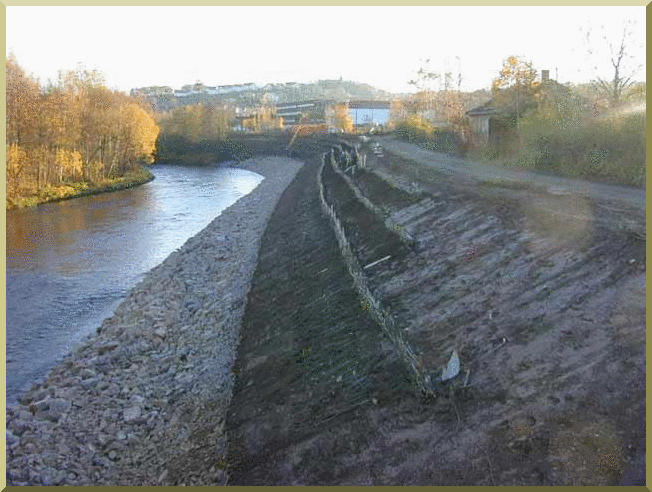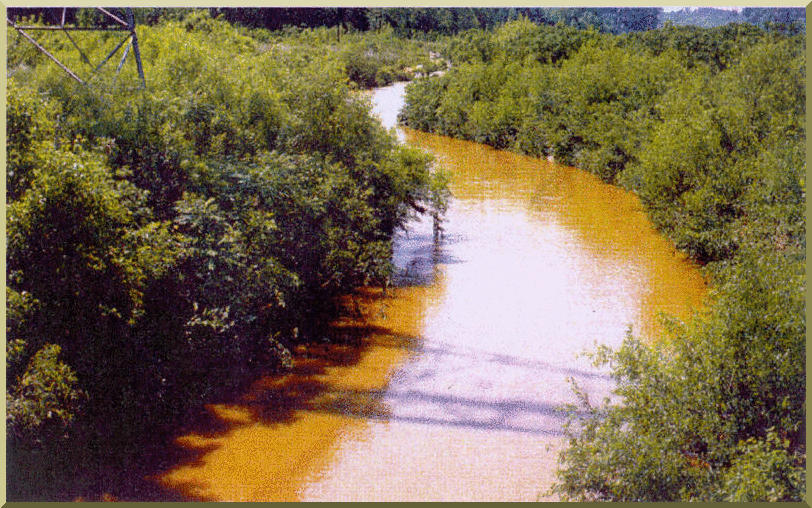|
OPEN-CHANNEL HYDRAULICS: LECTURE 063 - VEGETATED CHANNELS
1. VEGETATED CHANNELS 1.01 Vegetated channels, or channels lined with vegetation, are used in places where it is not advisable to line the channel with a rigid boundary. 1.02 In recent years, as environmental concerns have developed, vegetated channels have become a popular alternative to channel lined with rigid materials. Fig. 01
1.03 This table shows a comparison of vegetated channels and rigid-boundary channels.
1.04 The capability for channel infiltration is one of the main reasons for the selection of a vegetated channel in lieu of a rigid-boundary channel. 1.05 A vegetated channel can feed to groundwater, which a rigid-boundary channel cannot. Fig. 02
1.06 In many cases, groundwater replenishment may be important enough to warrant the choice of a vegetated channel. 1.07 Habitat function is a design consideration in cases where biodiversity may be threatened. 1.08 Generally, for a given design discharge, vegetated channels feature lower velocities and, therefore, larger cross sections. 1.09 Maintenance costs are substantially higher than those of rigid-boundary channels. 1.10 Most people consider a vegetated channel to be pleasing to the eye, as opposed to a concrete-lined channel. Fig. 03
Fig. 04
1.11 In summary, while a rigid-boundary channel focuses on conveyance effectiveness, a vegetated channel takes into account a host of environmental concerns, such as groundwater replenishment, contaminant filtering, biodiversity, and aesthetics. 1.12 Vegetated channels are increasingly being used in hydraulic engineering. 1.13 This table shows values of absolute roughness k and Manning's n for various types of vegetated channels.
2. GABION-LINED CHANNELS 2.01 Gabions are bank-stabilization structures consisting of mesh baskets filled with small rip rap. 2.02 A gabion structure may consist of several baskets. Fig. 06
2.03 Since the rip rap is enclosed with wire mesh, gabions have a high resistance to erosion. Fig. 05
2.04 Vegetation is able to grow within gabion structures. Fig. 07
2.05 Planting vegetation within gabions improves habitat, decreases flow velocity, and enhances the aesthetic appeal of the channel. 2.06 This table shows a comparison of gabion-lined channels and rigid-boundary channels.
2.07 Gabion structures provide a compromise between the good conveyance properties of rigid-boundary channels and the environmental friendliness of vegetated channels.
2.08 Gabion structures provide moderate rates of infiltration, moderate habitat function, medium design velocities, and moderate maintenance costs and aesthetics.
2.09 Gabions are also a compromise between riprap-lined channels and rigid-boundary channels.
2.10 When the same size rocks are used in gabions and rip rap, design velocities for gabions are 3 to 4 times higher than for rip rap.
2.11 The procedure for placing gabions consists of: 1. Assembling the gabion mats. Fig. 08
2. Placing the mats, wiring them, and filling the units with rock. Fig. 09
3. Closing and wiring down the lids. Fig. 10
2.12 There are several gabion manufacturers in the market.
2.13 Design velocities for gabion structures vary with the type of structure and the manufacturer's recommendations. 2.14 This table shows values of Manning's n for various types of channel lining.
3. NATURAL BANK STABILIZATION 3.01 Natural bank stabilization includes vegetative procedures to strengthen channel banks against erosion. 3.02 For proper habitat functioning in natural bank stabilization, three temporal wetting zones are considered: 1. Permanently wetted zone 2. Intermittently wetted zone, and 3. Event wetted zone, or flood plain. 3.03 Wattles and fascines are used in the permanently wetted zone. 3.04 Wattles consist of a row of stakes hammered into the ground. Fig. 11
Fig. 20
3.05 The stakes are braided with flexible strong brushwood. 3.06 Fascine sausages are cylindrical bundles of willow rods with diameters of 10 to 15 cm, used for streambank protection and bank stabilization. 3.07 They are manufactured with flexible brushwood and anchored with stakes of about 1 m length. Fig. 21
3.08 Fascine rolls are similar to fascine sausages, with a diameter of 25 to 40 cm. 3.09 Weighted fascines are cylindrical bodies with a diameter of 0.8 to 1.2 m. Fig. 12
3.10 They consist of a 15 to 20 cm thick coat of brush wood and a core of rough gravel or crushed rock. 3.11 Grass-lined channels, also called swales or bioswales, are used in urban drainage. Fig. 22
3.12 The intermittent zone is transitional between the permanently wetted zone and the flood plain. 3.13 Cattails are placed in the intermittent zone. 3.14 Various types of arrangements are used in the floodplain zone, including: 1. Lawns. 2. Lawn seeding. Fig. 13
3. Vegetative bank stabilization. 4. Woods, including brush mattresses, live staking and small trees and shrubs. Fig. 14
Fig. 15
Fig. 16
Fig. 17
Fig. 18
Fig. 19
3.15 This table shows values of maximum permissible velocity and critical tractive stress for various types of vegetative bank stabilization.
3.16 Design velocities for vegetated channels do not exceed maximum permissible velocities. 3.17 Design velocities are calculated with the Manning equation.
Eq. 1 3.18 Design tractive stresses should not exceed the critical tractive stresses. 3.19 Design tractive stresses are calculated with the bottom shear stress equation.
Eq. 2
Fig. 01
Fig. 02
Fig. 03
Fig. 04
Fig. 05
Fig. 06
Fig. 07
Fig. 08
Fig. 09
Fig. 10
Fig. 11
Fig. 12
Fig. 13
Fig. 14
Fig. 15
Fig. 16
Fig. 17
Fig. 18
Fig. 19
Fig. 20
Fig. 21
Fig. 22
Narrator: Victor M. Ponce Music: Fernando Oñate Editor: Flor Pérez
Copyright © 2011 Visualab Productions All rights reserved
|





















